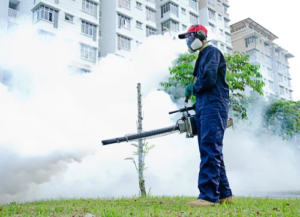Physical pest control involves creating barriers that prevent pests from entering buildings or gardens. This can include screens, netting, and fences. It also includes removing clutter where pests can hide.
Biological pest control uses natural predators or parasitoids to destroy pests. This can include nematodes that attack grubs and fish that kill mosquito larvae. Contact Pest Control Nampa now!

Pest identification is the first step in a pest control program. This step involves knowing what the pest is, its life cycle, and its behavior. This information helps identify and develop control methods that manage the pest without harming beneficial organisms or people. It also enables determining whether control actions are needed and when to take them.
Pests are not always easy to identify. Often they are very small or have similar colorations to their host plants, making it difficult to distinguish one from another. A good pest identification guide will have pictures that show the differences in size, shape and other characteristics of various types of pests, as well as information about their habitat requirements and life cycle.
Using a guide to help in pest identification will enable you to learn how to recognize different types of pests, such as the presence of characteristic damage to the host plant, or the presence of insect parts and frass (excrement). It is recommended that any person who regularly deals with pests should carry a pocket guide for rapid reference. It is also advisable to keep a logbook that records inspections and the action taken when pests are found. This information will provide an invaluable history of the pest infestation and enable you to determine trends.
A flashlight is a valuable tool in pest identification because it will enable you to inspect dark and secluded areas where pests may live or seek shelter. An extendable mirror is also useful for facilitating an inspection behind and beneath equipment or furniture. A magnifier is also helpful in identifying pests and their signs, such as egg masses or the gnawed ends of rodent tunnels.
Proper pest identification is vital for safely applying any type of pest control strategy. Pesticide products are typically labeled for specific pests, and it is important that the correct pest is identified before any application is made. This will ensure that the correct product is used and will not be inadvertently applied to non-target species.
In an integrated pest management (IPM) program, proper pest identification is essential for avoiding the unnecessary use of pesticides. IPM programs encourage routine scouting and monitoring of the environment for indicators of pest problems. This allows for a more targeted approach to pesticide applications, which minimizes environmental impacts.
Pest Prevention
The goal of pest prevention is to stop an infestation before it starts. This is done by taking a variety of different steps to prevent insects and rodents from entering buildings or living in them. This includes decluttering spaces, putting food in sealed containers, storing items away from the ground, and so on. It also means scouting for and identifying pests on a regular basis, using a trap or bait to eliminate them before they get out of hand, and cleaning up afterward.
Clutter and sloppy maintenance practices are some of the most common causes of pest infestations in homes and businesses. These include stacks of papers and cardboard, overflowing trash bins, and poorly maintained wood scraps. All of these can provide places for pests to hide and breed and make it easy for them to find food.
Keeping garbage cans securely closed, putting food in airtight and sealed containers, and regularly cleaning out the inside of refrigerators all help keep pests out of foods. It’s also a good idea to check the contents of grocery bags and containers before bringing them home, as some pests have super-sensitive olfactory senses that allow them to smell the food we eat from quite a distance. Pet foods should always be kept in securely enclosed containers as well.
Pests need moisture to survive and grow, so it’s important to minimize leaky faucets and drains in kitchens and bathrooms. In addition, ensuring that windows and vents are properly shut helps reduce humidity, which can be an incubator for some pest species.
It’s also a good idea to learn about a particular pest’s lifespan and life cycle, as it will help you recognize when the insect is in an egg, larval, nymphal or pupal stage. This will determine how effective certain interventions are, such as applying a repellent.
A successful pest control program is often a combination of methods, such as baits and traps or insecticide sprays. It’s important to identify the pest species first, however, because not all types of pests are the same and require different treatments.
Pest Control Methods
There are many methods for controlling pests. Some involve physical barriers, while others involve preventing or killing them with chemicals. The best method for you depends on the type of pest and the severity of the infestation. The goal should be to cause as little harm to the environment and other organisms as possible. Prevention is the best control, and you should use methods that will prevent pests from becoming a problem in the first place. These include scouting and monitoring, making sure that you know what pests are around so you can act quickly to control them.
Physical pest control includes reducing their food, water and shelter sources. Keep garbage cans tightly closed and dispose of them regularly, and eliminate places where pests can hide. Seal cracks and crevices in your home with caulk, and put steel wool or wire mesh over holes where pipes enter. Eliminate weeds that provide cover and food for pests, and close off their access to water by removing standing water. Clutter can also provide breeding sites for pests, so remove it as much as possible.
Chemical pest controls include repellents, which deter pests by releasing scents that are offensive to them, and insecticides, which kill them. These are available as sprays, dusts and baits. They may be effective against a wide range of pests, or targeted to specific species, and are typically easy to find and use. They can, however, damage other plants and animals if sprayed on them by accident, and they leave residues that may pollute the soil or water runoff.
Biological pest control uses natural enemies to control pest populations. These can be parasites, predators or pathogens, which can be introduced in large numbers to suppress pests. Parasitic nematodes, such as the worm-like Steinernema carpocapsae, can be sprayed on crops to kill off grubs and other insects. However, biological controls usually do not achieve eradication, and the degree of pest control fluctuates with environmental conditions.
Some natural forces influence all organisms, including pests, causing their numbers to rise and fall. These include climate, the presence of natural enemies, natural barriers, and the availability of food, water and shelter.
Pesticides
A pesticide is any substance that kills or controls unwanted plants, animals or germs. It can be in the form of a solid, liquid or powder and can be made from organic (carbon containing) materials or inorganic (non-carbon containing) substances. Examples of pesticides are insect killers, herbicides, fungicides and rodenticides. Pesticides are also used to modify a plant’s growth (regulators), drop a plant’s leaves prematurely (defoliants) or act as a drying agent (desiccant).
Pesticides can be man-made or natural and can be organic or inorganic. Some pesticides are so toxic that they require special handling and disposal procedures and may need to be stored in a locked cabinet or in a garage away from children and pets. Many municipalities set by-laws that regulate how, where and when pesticides can be applied on municipal lands.
Before using any pesticide, you must read and follow the manufacturer’s instructions and precautions. The label will provide important information such as the toxicity warning statements, the product’s target pests and situations, application rates, environmental impact and residual effects. It will also give the LD50 (the amount of chemical that it takes to kill 50% of laboratory mice).
Whenever possible, use non-chemical control methods before resorting to pesticides. When a pesticide must be used, choose the least hazardous one. This will be the one with a low toxicity rating, fast biodegradation, a narrow range of effectiveness and less harm to non-target plants or animals.
It is recommended that you wear the protective clothing suggested in the pesticide’s label, especially when mixing or applying. Always work in a well-ventilated area and avoid breathing fumes. Always use a mask when spraying. Avoid rubbing your eyes when touching chemicals. Always wash hands and arms when you have finished handling pesticides.
The use of pesticides must be limited and must never endanger people, pets, other animals, crops or property. It is not allowed to apply pesticides in ways that will cause contamination of groundwater, soil, air or water in the vicinity of the treated area. This includes the disposal of empty containers in a proper manner. It is also not allowed to expose infants, children, the elderly and sick people to harmful residues.






